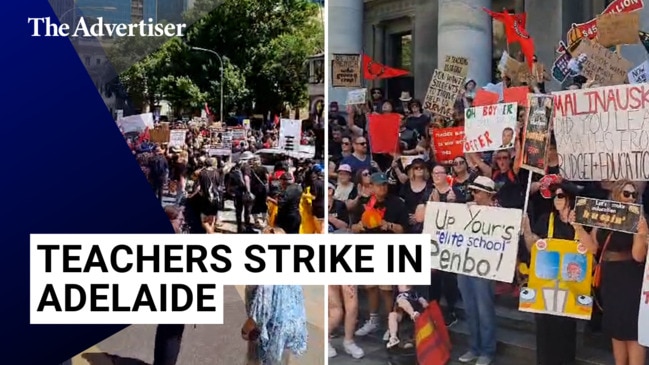Can South Australia afford to pay striking teachers as interest rates rise? | Paul Starick
Households are slashing spending as interest rates skyrocket and governments will have to tighten their belts too, Paul Starick writes.

Opinion
Don't miss out on the headlines from Opinion. Followed categories will be added to My News.
Householders have been slashing spending to cope with the steepest interest rate rises in the shortest period in 40 years.
Surely, governments will have to start doing the same sometime soon, as interest bills increase and revenues decline from current levels, particularly stamp duty and payroll tax.
Teachers have been striking for better conditions and more money. Who wouldn’t want more take-home pay during a cost-of-living crisis? But with South Australia’s debt to hit $37.56bn by the end of 2026-27, or $19,014.43 per person, can the state afford to meet teachers’ demands?
The Labor state government has been determined to fulfil big-spending election promises, particularly the flagship vow to fix the ambulance ramping crisis.
Almost two years after the 2022 election, though, Labor has thrown lots of money at the health system and, putting it generously, the ramping crisis is far from fixed.
But budgets have tightened since the heady days of early 2022, when Labor leader Peter Malinauskas boldly declared he had a future-focused agenda because “we’ve a once-in-a-lifetime, post-pandemic opportunity, this chance only comes around once”.

Since May last year, the Reserve Bank cash rate has risen 13 times, by 4.25 percentage points, adding $18,000 a year to repayments for a $600,000 mortgage. Just two months before that first rate rise, Labor won a state election in a landslide. Two days before that March 19 poll, Labor’s costings were released.
There were commitments to $979m of new operating initiatives and $2.14bn of capital spending, including $1.145bn on health. Treasury spokesman Stephen Mullighan said debt would increase over the four-year forward estimates to build health and education infrastructure during that time.
But changing circumstances mean changing outcomes. Interest rates have stayed higher for longer than expected, as evidenced by a Melbourne Cup day rate hike thought unlikely a few months ago.
The Economist news magazine gave a stark forecast for the world economy in its November 2 leader, or editorial, headlined: “The world economy is defying gravity. That cannot last.” The subhead was: “Threats abound, including higher-for-longer interest rates”.
It argued: “When interest rates were low, even towering debts were manageable. Now that rates have risen, interest bills are draining budgets. Higher-for-longer therefore threatens to pit governments against inflation-targeting central bankers.”

Doubts are already being raised about federal and state governments’ ability to afford the $368bn nuclear-powered submarine project centred on Adelaide under the AUKUS security pact, the $15.4bn Torrens to Darlington motorway and the $3.2bn new Women’s and Children’s Hospital.
These are all critical to the state. US Pacific Fleet commander Admiral Sam Paparo on Wednesday said the Adelaide submarine construction was a “essential part of AUKUS”.
“We are pooling talents, we are pooling resources and we are locking our futures together as three nations, so accordingly I think to the extent AUKUS increases the net industrial base of the three countries, it increases the net combat capability of all three countries together,” he said.
Changed times, though, can bring changed priorities. In February last year, the-then premier Steven Marshall hailed PwC’s promise to create 2000 hi-tech jobs at a Rundle Mall skilled service centre as strengthening SA’s position as “a hub for digital health innovation and as a world leader within the hi-tech sector”. On Wednesday, PwC said 141 jobs would be lost when it closed the skilled service centre and the 2000 jobs would not eventuate.
This is not an argument against nuclear-powered submarine construction, in particular, because that is a once-in-a-lifetime opportunity to transform the state’s economy with the intimate backing of our two closest allies.
Rather, it is warning that money doesn’t grow on trees and governments, like households, will have to cut their cloth somewhere, sometime soon.



